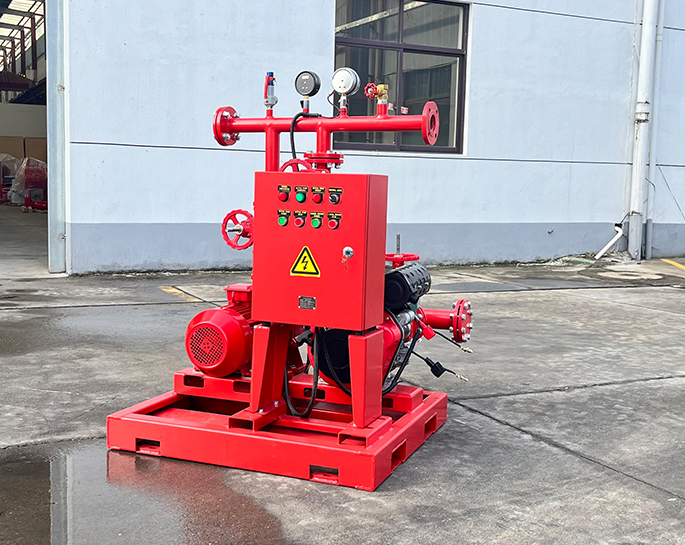What are the considerations for selecting the appropriate piping material for connecting electric fire pumps to the fire protection system?
Mar 29, 2024
Share:
Selecting the appropriate piping material for connecting electric fire pumps to a fire protection system involves several considerations to ensure reliability, safety, and compliance. Here are some key factors to consider:
1. **Compatibility with Fire Codes and Regulations**: Ensure that the selected piping material complies with relevant fire codes and regulations, such as NFPA (National Fire Protection Association) standards, local building codes, and insurance requirements.
2. **Corrosion Resistance**: Fire protection systems are typically designed to operate for extended periods without maintenance. Therefore, choose piping materials that are resistant to corrosion, especially if the system will be exposed to moisture or corrosive environments.
3. **Pressure and Temperature Ratings**: Consider the pressure and temperature requirements of the fire protection system, as well as the capabilities of the chosen piping material to withstand these conditions without failure or degradation.
4. **Flow Characteristics**: Evaluate the flow characteristics of the piping material to ensure that it facilitates the required flow rates for effective fire suppression.
5. **Mechanical Strength and Durability**: Select piping materials that possess adequate mechanical strength and durability to withstand the stresses associated with installation, operation, and potential impacts or accidents.
6. **Cost Considerations**: Balance the initial cost of the piping material with its long-term maintenance requirements and service life to determine the most cost-effective option for the specific application.
7. **Installation Requirements**: Consider the ease of installation and any specialized tools or techniques required for working with the chosen piping material.
8. **Availability and Accessibility**: Ensure that the selected piping material is readily available and accessible for purchase, installation, and maintenance.
9. **Compatibility with Other System Components**: Confirm that the chosen piping material is compatible with other components of the fire protection system, such as valves, fittings, and pumps.
10. **Environmental Impact**: Consider the environmental impact of the chosen piping material, including factors such as recyclability, energy consumption during production, and potential emissions or pollutants released during manufacturing or use.
Common piping materials used in fire protection systems include steel (both black and galvanized), stainless steel, copper, and various types of plastics such as CPVC (Chlorinated Polyvinyl Chloride) and PEX (Cross-linked Polyethylene). Each material has its own advantages and limitations, so it's essential to carefully evaluate these factors based on the specific requirements of the application. Consulting with a qualified engineer or fire protection specialist can help ensure that the chosen piping material meets the necessary criteria for the fire protection system.

1. **Compatibility with Fire Codes and Regulations**: Ensure that the selected piping material complies with relevant fire codes and regulations, such as NFPA (National Fire Protection Association) standards, local building codes, and insurance requirements.
2. **Corrosion Resistance**: Fire protection systems are typically designed to operate for extended periods without maintenance. Therefore, choose piping materials that are resistant to corrosion, especially if the system will be exposed to moisture or corrosive environments.
3. **Pressure and Temperature Ratings**: Consider the pressure and temperature requirements of the fire protection system, as well as the capabilities of the chosen piping material to withstand these conditions without failure or degradation.
4. **Flow Characteristics**: Evaluate the flow characteristics of the piping material to ensure that it facilitates the required flow rates for effective fire suppression.
5. **Mechanical Strength and Durability**: Select piping materials that possess adequate mechanical strength and durability to withstand the stresses associated with installation, operation, and potential impacts or accidents.
6. **Cost Considerations**: Balance the initial cost of the piping material with its long-term maintenance requirements and service life to determine the most cost-effective option for the specific application.
7. **Installation Requirements**: Consider the ease of installation and any specialized tools or techniques required for working with the chosen piping material.
8. **Availability and Accessibility**: Ensure that the selected piping material is readily available and accessible for purchase, installation, and maintenance.
9. **Compatibility with Other System Components**: Confirm that the chosen piping material is compatible with other components of the fire protection system, such as valves, fittings, and pumps.
10. **Environmental Impact**: Consider the environmental impact of the chosen piping material, including factors such as recyclability, energy consumption during production, and potential emissions or pollutants released during manufacturing or use.
Common piping materials used in fire protection systems include steel (both black and galvanized), stainless steel, copper, and various types of plastics such as CPVC (Chlorinated Polyvinyl Chloride) and PEX (Cross-linked Polyethylene). Each material has its own advantages and limitations, so it's essential to carefully evaluate these factors based on the specific requirements of the application. Consulting with a qualified engineer or fire protection specialist can help ensure that the chosen piping material meets the necessary criteria for the fire protection system.







